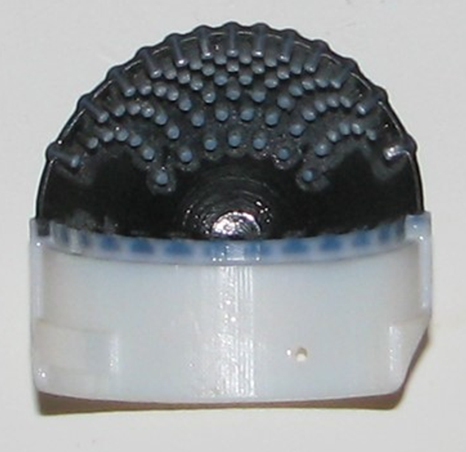Researchers at the University of Bristol in the UK have created a 3D printed fingertip that is designed for use by robots or as a component of robotic prostheses. The structure mimics the dermal papillae found in human skin, which are small bumps present between the dermis and epidermis that are important in human touch. In the printed fingertip, the papillae are created through a 3D printed mesh of pin-like structures that lie beneath a flexible “skin” coating, and their displacement and speed of movement inform the robot about the objects it is touching. So far, the artificial fingertips have been shown to mimic human skin quite closely when it comes to artificial neural recordings.
We tend to take the complexity and sophistication of our bodies for granted when performing everyday tasks, such as grasping something. However, our fingertips provide us with highly sensitive measurements on the characteristics of the surface we are touching, and allow us to apply the correct amount of force to manipulate a given object appropriately. Such complexities are not lost on researchers who attempt to emulate the body, such as those who create robotic prostheses or other robotic gripping devices.
At present, robots and robotic prostheses have a fairly limited grasp on the delicacies of gripping and manipulating objects. Applying the correct amount of force can be a difficult task when robot fingers cannot really feel what they come in contact with. This latest technology aims to change that. This 3D printed fingertip mimics human skin in an effort to improve its sensing abilities.
“Our work helps uncover how the complex internal structure of human skin creates our human sense of touch,” said Nathan Lepora, a researcher involved in the study. “This is an exciting development in the field of soft robotics – being able to 3D-print tactile skin could create robots that are more dexterous or significantly improve the performance of prosthetic hands by giving them an in-built sense of touch.”

To emulate the dermal papillae found in human skin, the researchers used a sophisticated 3D printer that can blend hard and soft material to create complex structures. They have compared artificial neural recordings obtained from the fingertip with real neural data to assess how close the artificial fingertip comes to the real thing.
“We found our 3D-printed tactile fingertip can produce artificial nerve signals that look like recordings from real, tactile neurons. Human tactile nerves transmit signals from various nerve endings called mechanoreceptors, which can signal the pressure and shape of a contact,” said Lepora. “Classic work by Phillips and Johnson in 1981 first plotted electrical recordings from these nerves to study ‘tactile spatial resolution’ using a set of standard ridged shapes used by psychologists. In our work, we tested our 3D-printed artificial fingertip as it ‘felt’ those same ridged shapes and discovered a startlingly close match to the neural data.”
Here’s a University of Bristol video about the project:
Study in Journal of The Royal Society Interface: Artificial SA-I and RA-I afferents for tactile sensing of ridges and gratings
